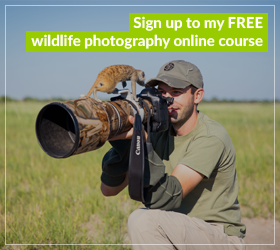Nat and I aren’t really ones for lying around on beaches, so we decided to go on safari for our honeymoon (yippee)! The day after our wedding we were on a plane to Zambia for two weeks of wildlife and relaxation. Obviously BeetleCam was not invited on this trip (although I did manage to sneak two camera bodies, 4 lenses, a couple of speedlite flashes and a tripod into our luggage)!
Our first stop was the spectacular Victoria Falls, also known by the indigenous Lozi people as “Mosi-oa-Tunya” (literally, “the Smoke that Thunders”). We were there shortly after the wet season and the volume of water flowing over the falls was incredible. In numbers, Victoria Falls is 1.7km wide, with a maximum drop of 108m and, at that time of year, approximately 3,000 tonnes of Zambezi River water flows over the falls every second! Standing in front of the falls, you get drenched by a deluge of spray that rises up over 400m and is visible up to 50km away. On the ground there is so much spray that it is impossible to appreciate the scale of the Victoria Falls… it is only from the air that you get a true sense of its magnitude.
Possibly my favourite image from the whole trip is this one of Nat looking out over the falls at sunset:
Our next stop was South Luangwa National Park. This is a beautiful park, teaming with animals. The Luangwa River runs through the heart of the park and provides a focal point around which the animals congregate. Below is a picture of the river at dusk and also a shot of some spoonbills feeding. The spoonbills were very comical to watch as they manically pursued small fish around the shallow pond.
A highlight of South Luangwa National Park is a trip to the enormous yellow-billed stork colony. This is the only colony of its size in the region and is an impressive spectacle, particularly at dusk when hundreds of birds fly in to roost. In the following photo I silhouetted the storks against rich purple African sky, shortly after sunset.
Another highlight of South Luangwa National Park was some of the nocturnal wildlife that we were able to see. One evening, after enjoying a lovely sunset on the banks of the Luangwa River, we were extremely fortunate to come across a beautiful Serval Cat on our drive back to camp. Since these cats are nocturnal, good sightings of them are few and far between. I was keen to get a decent shot of the Serval but I did not want to use a flash on an animal with sensitive night vision. This was my first trip with the new Canon EOS 1D Mk IV so I decided to really put its low light capabilities to the test by shooting only by the light of a single spotlight. The following shot was taken at 400mm, f/3.2 at ISO 8,000… I find it incredible that this was even possible and the resulting shot shows just how far digital cameras have come in recent years.
After South Luangwa we moved to Lower Zambezi National Park for the final leg of our trip. We spent most of our time cruising up and down the river watching elephants, buffalo and hippos. We stayed in a spectacular camp overlooking the Zambezi River… it was a very fitting and romantic end to our honeymoon!
Zambia is a wonderful destination for a safari… it is much quieter than other parts of Africa I have visited and boasts some beautiful national parks. I can’t wait to return someday to undertake a more in-depth photography project. To finish off this post, here is a picture of Mr. and Mrs. Spider in their web at sunset, overlooking the Zambezi River (you might have to look closer to spot Mr. Spider).












Congratulations and what wonderful photos ~
Congratulation and what an excellent serval picture! Easily my favourite serval pic!
CONGRATULATIONS.! What a wonderful place for your Honeymoon ! Congrats too on your VERY nice images .
( My wife and I went to the “FALLS ” by train in the early 60’s….Steam train of course….no Diesels or Electric units in those days….)
Thanks for sharing your good news….!
Excellent pictures!
And congratulations on your marriage, Will!
May you grow old together.
Regards from Cape Town.
thank-you for being careful regarding the cat–
I am equally concerned regarding insect eyes or wildlife because I am hypersensitive to light and white light can be very damaging. As for low light photography, does not surprise me. I have images taken from underneath nettles and dense undergrowth of insects in near darkness that pass through AGE using 400D and 50mm 2.5 with extensions and 100 + extensions. It’s a matter of patience and practice, but since I have no toleration for white light or flash, I hate to think of what that could do to the unformed eyes of dragonflies.Lycaenidae settle at dusk, so it’s a matter of constant training to work with low light or dusk.
congrats and great way to celebrate your marriage. thank-you for sharing it.
Great pictures! thanks so much . It gives me just a taste of your trip. I know your hearts will be forever changed for having gone.
Congrats with your marriage and the African bush is a great place for a honeymoon. There is a lesson in the spider photo and you will learn it with time 😉
Regards from Port Elizabeth